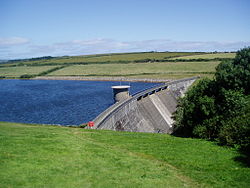Drift Reservoir
| Drift Reservoir | |
|---|---|
 |
|
| Location | Cornwall |
| Coordinates | 50°06′29″N 5°35′28″W / 50.1080°N 5.5910°WCoordinates: 50°06′29″N 5°35′28″W / 50.1080°N 5.5910°W |
| Type | reservoir |
| Basin countries | United Kingdom |
| Max. length | 1,200 yd (1,097.3 m) |
| Surface area | 65 acres (26 ha) |
| Max. depth | 48 ft (14.6 m) |
| Water volume | 1,200 million litres (970 acre·ft) |
| Surface elevation | 275 feet (83.8 metres) |
Drift Reservoir is a reservoir in Cornwall, England, UK, just north of the village of Drift and west of Penzance. The reservoir is just over a kilometre long and covers 26 ha. The dam is at the southern end of the reservoir, and the northern end, splits into north-western and north-eastern shallow arms. It is currently managed, jointly by the South West Lakes Trust and South West Water. There is public access to the dam and parking area only.
The reservoir was first given statutory approval in 1938 (Under the Penzance Corporation Act 1938) but construction was deferred until after World War II and finally completed by the West Cornwall Water Board in 1961. It is the principal source of water for the Penwith area.
Drift reservoir, due to its geographical location close to the sea, plus good areas of shallow water and exposed mud is an important landfall for migrating waders. The north-west arm of the reservoir is managed by the Cornwall Birdwatching and Preservation Society (CBWPS) and the bird hide, due to insurance considerations, is open to members of that organisation only. A successful bird reserve needs an area that is free of continuous disturbance and in 2001 a no fishing area was established in the north-west arm, along with a reed bed of Phragmites australis. A year later it was reported that the no fishing area had helped breeding birds which included common coot (Fulica atra), mallard (Anas platyrhynchos) and mute swan (Cygnus olor).
Although generally hosting only small numbers of birds (244 species recorded), the reservoir has attracted a considerable number of North American vagrant shorebirds and wildfowl, including a number of lesser scaup (Aythya affinis). In May 2016 a Dalmatian pelican (Pelecanus crispus) was seen in western Cornwall and was frequently seen on the reservoir. There are 5,000 year old fossil remains of this species from Somerset and this bird could be the first recorded in Britain since then. At the same time as the Dalmatian pelican, a cackling goose, (Branta hutchinsii), which is a scarce but regular North American vagrant was at the reservoir.
...
Wikipedia
